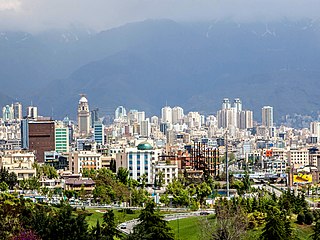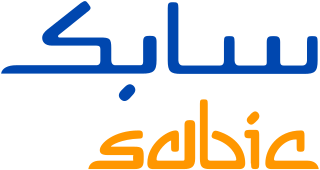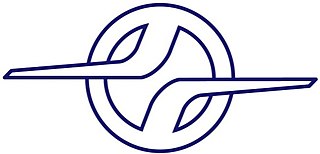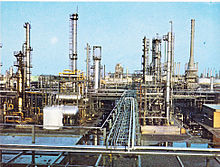
Iran has a mixed, centrally planned economy with a large public sector. It consists of hydrocarbon, agricultural and service sectors, in addition to manufacturing and financial services, with over 40 industries traded on the Tehran Stock Exchange. With 10% of the world's proven oil reserves and 15% of its gas reserves, Iran is considered an "energy superpower". Nevertheless, since 2024 Iran is suffering from an energy crisis. Also, some allegation were made that Iran manipulates its economic data.

Iran Khodro, branded as IKCO, is an Iranian automaker headquartered in Tehran. IKCO was founded in 1962 as Iran National. The public company manufactures vehicles, including Samand, Peugeot and Renault cars, and trucks, minibuses and buses. As of 2009, it produced 688,000 passenger cars per year.

Bank Melli Iran is the first national and commercial retail bank of Iran. It was considered as the largest Iranian company in terms of annual income with a revenue of 364 657 billion Rials in 2016. It is the largest bank in the Islamic world and in the Middle East. By the end of 2016, BMI had a net asset of $76.6 billion and a network of 3.328 banking branches; so it was known as the largest Iranian bank based on the amount of assets. The brand of BMI was recognized as one of the 100 top Iranian brands in 10th National Iranian Heroes Championship in 2013. The National Bank has 3328 active branches inside, 14 active branches and 4 sub-stations abroad, and it has 180 booths. The first managing director of BMI was Kurt Lindenblatt from Germany, the first foreign branch of BMI was opened in Hamburg, Germany in 1948.

SAIPA is an Iranian automaker headquartered in Tehran. The SAIPAC was established in 1965 as with 75% Iranian ownership, to assemble Citroëns under license for the Iranian market. It changed its name into SAIPA in 1975 when Citroën withdrew from the company. Its products in recent years have been mostly under-licensed Korean cars and its own engine and range of cars. The chief executive of SAIPA is Ali Sheikhzadeh.

Iran’s automotive industry is the third most active industry of the country, after its oil and gas industry, accounting for 10% of Iran's GDP and 4% of the workforce.

Saudi Basic Industries Corporation, known as SABIC, is a Saudi chemical manufacturing company. 70% of SABIC's shares are owned by Saudi Aramco. It is active in petrochemicals, chemicals, industrial polymers and fertilizers. It is the second largest public company in the Middle East and Saudi Arabia as listed in Tadawul.

Wagon Pars is an Iranian train and locomotive manufacturer established in 1974, in Arak. Products include locomotives, trains, metros, freight and fuel railroad cars, and equipment for passenger boarding of aircraft. It is the largest rolling stock manufacturer in the Middle East.

Asaluyeh is a city in the Central District of Asaluyeh County, Bushehr province, Iran, serving as capital of both the county and the district. It also serves as the administrative center for Asaluyeh Rural District.

The Tehran Stock Exchange (TSE) is Iran's largest stock exchange, which first opened in 1967. The TSE is based in Tehran. As of October 2024, 663 companies with a combined market capitalization of US$ 94 billion were listed on TSE. TSE, which is a founding member of the Federation of Euro-Asian Stock Exchanges, has been one of the world's best performing stock exchanges in the years 2002 through 2013. TSE is an emerging or "frontier" market.
The Iranian Oil Bourse, International Oil Bourse, Iran Petroleum ExchangeKish Exchange or Oil Bourse in Kish also known as Iran Crude Oil Exchange, is a commodity exchange, which opened its first phase on 17 February 2008.
The Industrial Development & Renovation Organization of Iran (IDRO) known as IDRO Group was established in 1967 in Iran. IDRO Group is one of the largest companies in Iran. It is also one of the largest conglomerates in Asia. IDRO's objective is to develop Iran's industry sector and to accelerate the industrialization process of the country and to export Iranian products worldwide. Today, IDRO owns 117 subsidiaries and affiliated companies both domestically as well as internationally.

The National Petrochemical Company (NPC), a subsidiary to the Iranian Petroleum Ministry, is owned by the government of the Islamic Republic of Iran. It is responsible for the development and operation of the country's petrochemical sector. Founded in 1964, NPC began its activities by operating a small fertilizer plant in Shiraz.

The construction industry of Iran is divided into two main sections. The first is government infrastructure projects, which are central for the cement industry. The second is the housing industry. In recent years, the construction industry has been thriving due to an increase in national and international investment to the extent that it is now the largest in the Middle East region. The Central Bank of Iran indicate that 70 percent of the Iranians own homes, with huge amounts of idle money entering the housing market. Iran has three shopping malls among the largest shopping malls in the world. Iran Mall is the largest shopping mall in the world, located in Tehran. The annual turnover in the construction industry amounts to US$38.4 billion. The real estate sector contributed to 5% of GDP in 2008. Statistics from March 2004 to March 2005 put the number of total Iranian households at 15.1 million and the total number of dwelling units at 13.5 million, signifying a demand for at least 5.1 million dwelling units. Every year there is a need for 750,000 additional units as young couples embark on married life. At present, 2000 units are being built every day although this needs to increase to 2740 units. Iran's construction market will expand to $154.4 billion in 2016 from $88.7 billion in 2013.
According to the Fourth Five-Year Economic Development Plan (2005–2010), the Privatization Organization of Iran affiliated with the Ministry of Economic Affairs and Finance is in charge of setting prices and ceding shares to the general public and on the Tehran Stock Exchange. The privatization effort is primarily backed by reformist members of the Iranian government and society who hope that privatization can bring about economic and social change.

Following the Iranian Revolution, Iran's banking system was transformed to be run on an Islamic interest-free basis. As of 2010 there were seven large government-run commercial banks. As of March 2014, Iran's banking assets made up over a third of the estimated total of Islamic banking assets globally. They totaled 17,344 trillion rials, or US$523 billion at the free market exchange rate, using central bank data, according to Reuters.
Ghadir Investment Company was established in 1991 in Iran and entered to the "Tehran Stock Exchange (TSE)" in 1995. Its activities are managing or restructuring Iranian companies on behalf of its share holders. GHADIR is one of the biggest holding investment company in the Tehran Stock Exchange (TSE) with a market capitalization of 97,416 billion Iranian Rials as of 2017.

According to a report by The Economist, Iran has been ranked 39th for producing $23 billion of industrial products in 2008. From 2008 to 2009 Iran has leaped to 28th place from 69th place in annual industrial production growth rate.

Iranian Rail Industries Development Co (IRICO) is an Iranian manufacturer of passenger rolling stock. The company was founded in 2003 and began series production of rail vehicles in 2009. The company has several license manufactured rolling stock in cooperation such as Hyundai Rotem, Siemens, Stadler & CRRC Puzhen.
Renault Pars is an Iranian joint venture established in 2004 and owned by Renault and Iran's Industrial Development Renovation Organisation (IDRO). The company is in charge of managing the assembly of CKD Renault cars by local manufacturers Iran Khodro and SAIPA's Pars Khodro.
The Iran National Auto Loan was a short lived financial arrangement between the government of Hassan Rouhani Central Bank of the Islamic Republic of Iran, Iran Khodro, SAIPA and other Iranian car manufacturers who produced cars within the country.














